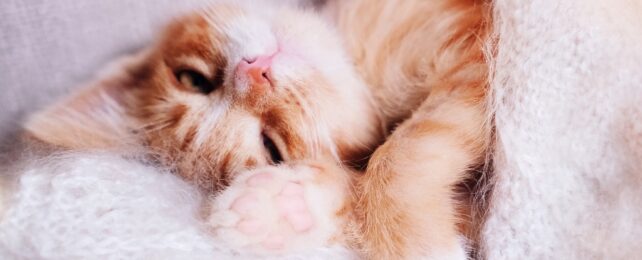It turns out your cat's purr is set on autopilot. Researchers have finally discovered the key to these fluff-ball's signature sound, which involves squishy pads in a cat's vocal cords.
Scientists have puzzled over how cats manage to make their distinctive low-pitched purr, as low frequency sounds are usually made by larger animals with longer vocal cords.
These 'purring pads' of connective tissue embedded in the vocal folds appear to increase the density, making them vibrate more slowly to produce the rumble that brings joy to their humans.
The international team led by voice scientist Christian Herbst from the University of Vienna in Austria says their research challenges the widely held belief that active muscle contractions are what cause purring.
Instead, the scientists think that purring may be a passive aerodynamic behavior that continues automatically after the brain sends an initiating signal.
"These low-frequency vocal fold vibrations involve a special vocal mode with an unusually long closed quotient, reminiscent of the "vocal fry" register in humans," the researchers write in their published paper.
When we speak with vocal fry, we create a low-pitched, raspy sound by vibrating the vocal cords at a very low frequency, sometimes described as a 'droning' or a 'gravelly' voice. The thickness of the opening and level of tension in the vocal cords, as well as the airflow through them, all contribute.
The purring pads work in a similar way, allowing small cats to purr even though their vocal cords are much shorter than ours, using the same mechanisms that usually generate higher-frequency vocalizations like meows.
Collagen and elastin fibers in the vocal cord's connective tissues are arranged in structures that, like in roaring cats, dampen the high frequencies of their sounds.
These structures, up to 4 millimeters in diameter, had been previously discovered in domestic cats, but their role in purring hadn't been explored.
To look into this, Herbst and colleagues removed the larynges, which house the vocal cords, from eight deceased domestic cats. Then they pressed the vocal cords together and pushed warm, humidified air through them.
Without any muscle contractions or neural input, all eight larynges produced a purring sound from self-sustained vocal fold oscillations at frequencies in the range of domestic cat purring, between 25 and 30 Hz.
This surprising finding shows that muscle contraction is not essential for purring. The connective tissue structures may be the primary driver, though this would need to be proven by measuring the process in living cats, which is a little more difficult.
"While our data do not fully reject the active muscle contraction hypothesis for purring," the team writes, "they show that cat larynges can easily produce sounds in the purr regime with fundamental frequencies of 25 to 30 Hz without neural input or muscular contraction."
The reason why cats purr remains a mystery. Some theories suggest purring indicates contentment and encourages further interaction with their humans. Research also suggests that purring could be a healing mechanism.
The research could lead to new insights into the role of purring in cats' health and well-being. This might help scientists develop new technologies that mimic the purring sound, such as calming devices for cats or even new treatments for pain and anxiety.
The study has been published in Current Biology.
